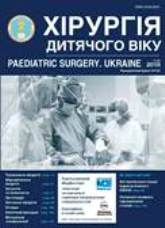Experience of treating children with magnets in the gastrointestinal tract
DOI:
https://doi.org/10.15574/PS.2018.60.56Keywords:
children, neodymium magnets, gastrointestinal tractAbstract
Introduction. The probability of neodymium magnets ingestion in the gastrointestinal tract (GIT) by children is very high, however, there is still no unified treatment algorithm of their removal: some authors recommend to wait, while others insist on immediate endoscopic removal or surgery.
Objective: management improvement of treating children with magnets in the gastrointestinal tract.
Material and methods. There were 7 children with magnets in their GIT followed-up. All children underwent complete general clinical and instrumental examination (abdominal ultrasound, abdominal X-ray).
Results. The examination revealed gastric location of magnets in 3 (42.9%) children: in 1 case, it was passed in the stool, in 1 case – removed using EGDS, and 1 case required a gastrotomy. In the rest 4 (57.1%) children magnets were detected in the intestine, and laparotomy was performed for peritonitis and intestinal obstruction. Six children (85.7%) were recovered. Based on the results of case study, a treatment algorithm is developed for the suspected swallowed magnets of GIT.
Conclusions. At suspicion on neodymium magnets ingestion, one must not waiting it to traverse the gastrointestinal tract and pass in the stool spontaneously. An anamnesis should be carefully taking as well as abdominal X-ray and abdominal ultrasound must be conducted. Further medical tactics depends on the number of magnets and time lapse since ingestion: the more magnets are swallowed, the faster laparotomy should be performed.
References
Antonova ЕV, Kholostova VV, Khalafov RV. (2013). The case of long-term finding of foreign magnetic bodies in the stomach. Children's surgery. 2:52-53.
Bodnar OB, Bodnar MB, Khaschuk VS, Zbanchuk OO. (2014). Foreign bodies in the gastrointestinal tract (magnets) of a 4-year-old child. Clinical and Experimental Pathology. 13; 2(48): 24-6.
Grishin OO, Pritulа VP, Kolomiets IV et al. (2012). Magnets – aggressive foreign bodies in the gastrointestinal tract in children. Actual questions of treatment children with surgical pathology: Materials of a scientific-practical conference with international participation. Kyiv: 52-4.
Grona VN, Buslaev AI, Kolodyazhnyi RP. (2013). Magnets – aggressive and dangerous foreign bodies in the digestive canal in children. Child’s health. 4(47): 119-21.
Lapshyn KV, Nakonechnyi AI, Kocherkevych ОN. (2017). Foreign bodies (magnets) in esophagus and stomach of a child. Pediatric Surgery. Ukraine. 2(55): 111-3. https://doi.org/10.15574/PS.2017.55.111
Rybalchenko VF, Domansky OB, Gnatyuk SM, Bondarenko SI. (2012). Foreign objects (magnets) in the intestines of children. Pediatric Surgery. Ukraine. 3: 86-9.
Abbas MI, Oliva-Hemker M, Choi J, Lustik M, Gilger MA, Noel RA et al. (2013, July). Magnet Ingestions in Children Presenting to US Emergency Departments. Journal of Pediatric Gastroenterology and Nutrition:57(1):18–22. doi 10.1097/MPG.0b013e3182952ee5
Butterworth J, Feltis B. (2007). Toy magnet ingestion in children: revising the algorithm. Pediatr. Surg. 42: 3–5. doi.org/10.1016/j.jpedsurg.2007.09.001.
Hussain SZ, Bousvaros A, Gilger M, Mamula P, Gupta S, Kramer R. (2012). Management of Ingested Magnets in Children. Journal of Pediatric Gastroenterology and Nutrition. 55(3):239–42. https://doi.org/10.1097/MPG.0b013e3182687be0; PMid:22785419
Moussouras N, Pratt CA, Neilson I. (2008). Magnetic toy ingestion: surgical implications. Alaska Med. 49(4):117–9. PMid:18491803
Oestreich AE. (2009). Worldwide survey of damage from swallowing multiple magnets. Pediatric Radiology. 39(2):142–7. doi 10.1007/s00247-008-1059-7
Shruti J, Guy DE. (2013). A systematic review of paediatric foreign body ingestion: Presentation, complications, and management. International Journal of Pediatric Otorhinolaryngology. 77(3):311-7. doi 10.1016/j.ijporl.2012.11.025
Downloads
Issue
Section
License
The policy of the Journal “PAEDIATRIC SURGERY. UKRAINE” is compatible with the vast majority of funders' of open access and self-archiving policies. The journal provides immediate open access route being convinced that everyone – not only scientists - can benefit from research results, and publishes articles exclusively under open access distribution, with a Creative Commons Attribution-Noncommercial 4.0 international license(СС BY-NC).
Authors transfer the copyright to the Journal “PAEDIATRIC SURGERY.UKRAINE” when the manuscript is accepted for publication. Authors declare that this manuscript has not been published nor is under simultaneous consideration for publication elsewhere. After publication, the articles become freely available on-line to the public.
Readers have the right to use, distribute, and reproduce articles in any medium, provided the articles and the journal are properly cited.
The use of published materials for commercial purposes is strongly prohibited.

